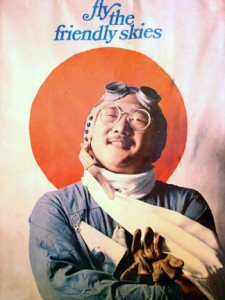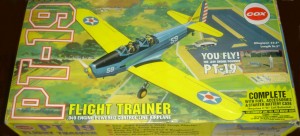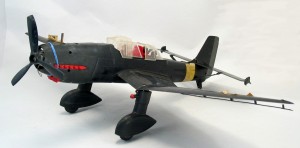Late one Chicago summer morning in the early ‘70s, Al Weninger, an art director I worked with at Tatham-Laird & Kudner on the Libby’s Food account, poked his head into my office and gestured to follow him. He also motioned to Bill Klimas and Dennis Takata, another writer and art director in our group, as we passed their offices. He led us to his office. On his drawing board was a large brightly colored box with a picture of a model airplane flying high above the landscape. With a big grin on his face, Al removed the lid and revealed a yellow and blue plastic airplane with a 22-inch wingspan that he had just purchased. It was an engine powered, control line “Flight Trainer.” A trainer is specifically designed for people who have never flown a model plane before; it is held together with rubber bands so if it crashes only the bands would break – not the plane.
Al invited us along to help him fly his plane at the park near Navy Pier during lunch. On the way out of the agency, he ducked into the art supply room and grabbed five or six art boards and some masking tape. I must have looked puzzled because he smiled and said, “runway.” At the park, we taped the boards end-to-end to form a smooth takeoff surface on top of the grass.
Al put fuel into the engine from a small tin container, attached the wire clip from the battery case to the glow plug, and flipped the propeller a few times with his forefinger while Bill gingerly held the tail section of the plane. There was a small knurled adjusting screw that Al fiddled with as the engine would start and then sputter to a stop. Finally, the tiny engine roared to life with an annoying high-pitch sound. Al grabbed the control handle and walked the length of the strings. He moved his wrist from side-to-side so the handle would pull the strings that raised or lowered the flaps. Then he signaled Bill to let go. The plane roared down the makeshift runway and lifted off the ground on the first try. We all watched as the plane made a few wild up and down moves and uncontrolled loops before coming in for a crash landing – snapping the rubber bands and breaking apart. We reassembled it with new rubber bands and fired it up again.
Once Al got the hang of it and could land the plane safely, we then each began taking turns. Within a couple hours, there was absolutely nothing left of the plane except a large quantity of broken plastic parts and snapped rubber bands. I don’t think the engineers of this breakaway plane had us in mind when they designed it. Al threw the mess into the box and lugged it back to the agency. Later that afternoon, he attached strings to the broken parts and hung them from his office ceiling as a “memorial” mobile.
The flying bug immediately bit the four of us. The following weekend we purchased our own planes – and not trainers either because we each assumed we were past the major crash stage.
As I remember, Al bought a bright red and white, bi-wing stunt plane. I found a black Stuka dive-bomber sporting a red plastic bomb underneath its belly. Bill and Dennis co-incidentally purchased P-40 fighters or something similar.
My Stuka minus the red bomb and a few other parts.
I can’t believe I’ve kept it for 38 years.
The following Monday we brought our new planes to the office and headed to the park at noon, except for Dennis. He stayed behind claiming he wanted to customize his plane first.
We continued our flying escapades almost every afternoon for a couple weeks without Dennis. Curiosity finally won out and we asked him what was taking so long. He explained with a smile that he wanted to duplicate the paint scheme of a WW II Japanese Zero in honor of his ancestry, so he had been spending his time airbrushing the fuselage and hand painting various parts.
A few days later he unveiled his work. It was absolutely beautiful. The light olive green paint on top slowly faded along the sides into a dull white on the underbelly. Small details on the wings, tail, and body were deftly painted by hand. Even the plastic pilot inside the cockpit appeared in authentic Japanese aviator colors.
We all wanted to contribute something to this piece of art and the spirit of Dennis’ pursuit. I found some round red stickers used by my local Jewel Foods store that were the perfect size for the circular red Japanese wing and fuselage insignias. Al found a photographer’s promotional wall poster that was so apropos to Dennis’ endeavors; you would think Al designed it himself. It was a color poster of a Japanese man in WW II aviator’s coveralls, leather pilot’s helmet, and white flying scarf with his arms folded in front and a smile on his face. A Japanese flag hung in the background. The headline proclaimed “Fly the Friendly Skies,” an obvious spoof of the tag line for United Airlines. I didn’t know at the time that the person on the poster was Glenn Fujimori, a Chicago art director, who would soon become my art partner when I joined Leo Burnett a couple years later.
The big day arrived – the poster was hung, the red insignias were carefully applied. We headed for the park. While the rest of us took turns flying our planes, Dennis fussed over the fueling process to make certain nothing spilled on his beautiful paint job.
Finally, he was ready. One of us flipped the propeller to start the plane. Dennis grabbed the control cables. The plane roared to life. When it was released, it sped down the runway, swooped up into the air making one gigantic loop and then crashed full force, nose first, straight into the ground. Pieces flew. I could swear a wisp of smoke drifted up to complete the scene.
None of us moved. We just stared at the shattered plane – our mouths agape. Dennis stood motionless, his face expressionless, his hand and arm frozen straight out in front of him grasping the now limp control lines. We tried to comfort him with words of sorrow and regret as we picked up the broken pieces and handed them to him. He stared blankly ahead holding the broken plane against his chest as we gathered in a semi-circle in front of him. Then with a sigh and slight smile he quietly and slowly remarked, “I guess, it‘s just the Kamikaze in me.”





Sounds like you guys took LONG lunches! Cheers!
Hi Joel,
Gary Needham TLK 1970-1975 Art Director.
I think back to those days…We all screwed around so much I wonder how we ever got the work done. When I started at TLK was on 64 E. Jackson. Started out in Jack Trindal’s group, with Roy Clark, Kurt Orson and Bill Klimas. My office was between Mike Malatec and Kurt Orson. The third week that I was there. I was working though lunch in my office. A old man shuffled in to my office with a slide in his hand. He ask how could he get a copy of the slide. I was new to advertising and thought that was an odd question to be asking in a ad agency. But to humor the old guy, I wrote down the number to gamma lab. Told him to give them a call for a pick up. He thank me and shuffled out. I went back to work thinking nothing of it. About ten minutes later a guy from the building came in and told me that there had been a boom scare in the building. He ask did I see anybody strange walking around. Then I told him about the strange old man that came by. He called some one on his walkie-talkie. Thanked me and rushed off down the hall. About a half hour later… Jack walked in telling me how they wouldn’t let any one back in to the building. Then I told him that I think I saw the guy. I went on to tell him about my encounter. He ask what was the slide of? I said a bull. He said come with me, so we walked to the other side of the floor into a conference room. He pointed to a large picture on the wall. I said that’s the guy. He started to break up. He told me that’s Art Tatham. He spent the rest of the afternoon telling everyone on the floor. When Mr. Tatham retired at his retirement party the store was re-told as I stepped out of a large Bendex Washing Machine. Bendex was the agencies first account.
There were so many crazy things that when on their. Both at 64 E Jackson and it continued on to 625 N. Michigan.
Hi, Joel–I remember Glenn Fujimori. He was at Burnett when I was there. Years later, my wife and I returned to Chicago for her 25th high school reunion (Sullivan HS) Among those attending was Glenn–who I sort of recognized but couldn’t quite place. He explained that he never attended Sullivan, but grew up in that north side neighborhood and was friends with a lot of kids that went there. As we talked further, he mentioned that he was an art director at Burnett. I had been a copywriter there, but we’d never worked together or were even in the same group. But I suddenly got this flash memory: Glenn and Don Novello in an elevator in handcuffs–busted for smoking grass in Grant Park! THAT was why I remembered him.
For some strange reason, I thought about the “Fly the friendly skies” poster that was given to me by someone who I can’t remember now. The size of the “poster” was approximately three feet by four feet and was perfectly done. I was a manager at Toyota Motor Sales until I retired about ten years ago. The people who really liked this poster were all from higher-up positions with Toyota. Now — I’m talking about forty years ago, and I think that one of those “representatives” got into my office after all the other employees (including myself) had gone home for the day and nonchalantly absconded with my treasure. Anyway, I happened to think about that poster a little while ago so just for the heck of it, I tried punching the title into my computer. And I’ll be darned — the same exact picture came up on my screen. Now I can have those memories of forty years ago with me all the time now. I must honorably thank all of you for bringing this back to me.
I used to have that poster back in the 70’s at my parents house. We had it on our living room wall. The poster was up so long that it fell apart when we removd it from the wall. loved that poster.